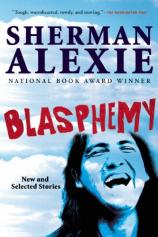Blasphemy: New and Selected Stories
Review
Blasphemy: New and Selected Stories
In his newest collection, BLASPHEMY, Sherman Alexie creates Native Americans who experience restlessness and a search for place, discrimination against and from whites, and the lack of urgency to live and prosper. Many of the narratives are set in and around a Spokane reservation in Washington State, and sadness and poignancy are all too believable; after all, when one of the defeated narrators returns home to the reservation, “his family had been expecting him back since the day he left.”
And basketball. The Indian boys’ need for identity intersects with their prowess at basketball, and some of the stories are rich with their exploits in unbelievable games. In “What Ever Happened to Frank Snake Church?” Frank scores a winning hoop after taunts and hardships during the game. The man he scored against, Double O, lies on the floor and flails his arms and legs. “He laughed and hooted and cursed…he was proud of playing a game that could produce such a random, magical and ridiculous highlight.” The Indian boys’ expertise is built on stamina, cunning and skill and, even though the joy at winning is almost always short-lived, represents another thread in the stories.
"Alexie shows a cultural bias against Indians so ingrained that it is almost matter-of-fact. This understanding shows how good the stories are: they make us ashamed for the bigotry yet glad for the revelation."
The storylines vary greatly, but Alexie does not go far from the central theme of heartbreaking alienation. “Assimilation” shows a dinner date between an Indian wife and her white husband after she has seduced an Indian man that afternoon. She wanted “to have sex with an indigenous stranger,” so she does. Fraught with racial indignities on both sides, their marriage seems stronger and more passionate as they witness a tragedy on the way home to their children. Their cultural differences remain, although the tension of the night brings them together.
In another story, “The Lone Ranger and Tonto Fistfight in Heaven,” a young Spokane goes to a 7-Eleven at three in the morning for a Creamsicle and some company. He enters the store and feels the eyes of the clerk looking him over so he “could describe me to the police later.” It is a look he recognizes; he left a girlfriend when she said he was looking at her that way because “when one person starts to look at another like a criminal, then the love is over.” He goes back to his reservation after the break-up, and at the basketball gym one night he meets a white man who needs to be “beaten by an Indian, any Indian.” Our Tonto loses. He again retreats to Seattle where he works at the high school exchange program typing and answering phones. And he wonders “if the people on the other end of the line know that I’m Indian and if their voices would change if they did know.” The Indian men are aware of distrust and discrimination, yet they have no resources to resist.
A Native American’s awareness of place in society is found in “Indian Education,” where each grade of school teaches a lesson. For instance, Eighth Grade is set in a girls’ bathroom where sounds of vomiting are overheard amid whispers of bulimia. The narrator thinks of his mother on the reservation standing in line for commodities, happy to have canned beef that dogs wouldn’t eat. Even though they have food, his family “grew skinny from self-pity.” There is poignancy in the comparison between the girls who are skinny for one reason and the Indians who are skinny for quite another. The Postscript: Class Reunion is a single paragraph: “Victor said, ‘Why should we organize a reservation high school reunion? My graduating class has a reunion every weekend at the Powwow Tavern.” Stereotyping? It appears to be, but it also seems part of Indian education and life.
Alexie surprises as well. In “Emigration,” a father believes the trees that his three daughters inhabited will accept flames gladly and burn and “the smoke will rise into the dark and spell words from the tribal language which I never learned to speak.” The appropriate nod to magic and mysticism is seen in several pieces.
Although not all of the stories are bleak, this collection is primarily about Native Americans struggling to live worthwhile lives in this century without forgetting the past centuries of misuse. Alexie shows a cultural bias against Indians so ingrained that it is almost matter-of-fact. This understanding shows how good the stories are: they make us ashamed for the bigotry yet glad for the revelation.
Reviewed by Jane Krebs on October 26, 2012
Blasphemy: New and Selected Stories
- Publication Date: October 8, 2013
- Genres: Fiction, Short Stories
- Paperback: 480 pages
- Publisher: Grove Press
- ISBN-10: 0802121756
- ISBN-13: 9780802121752





